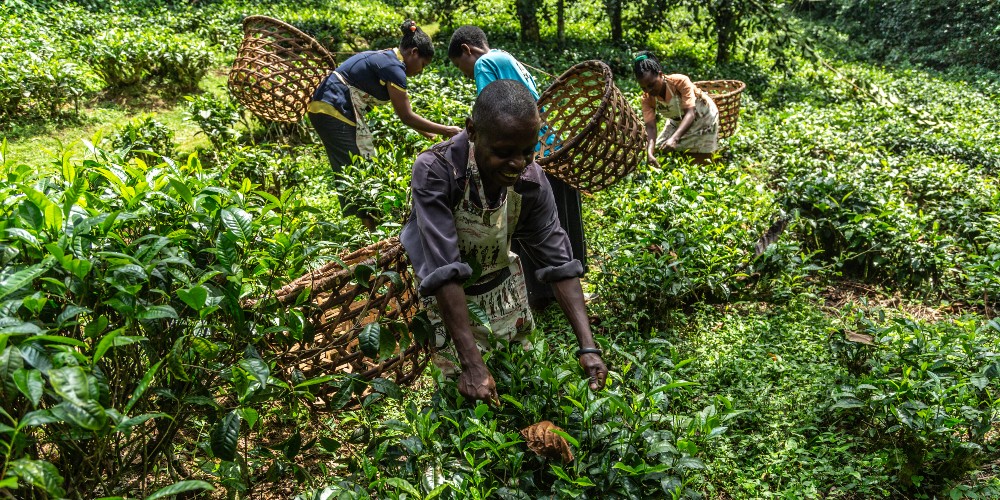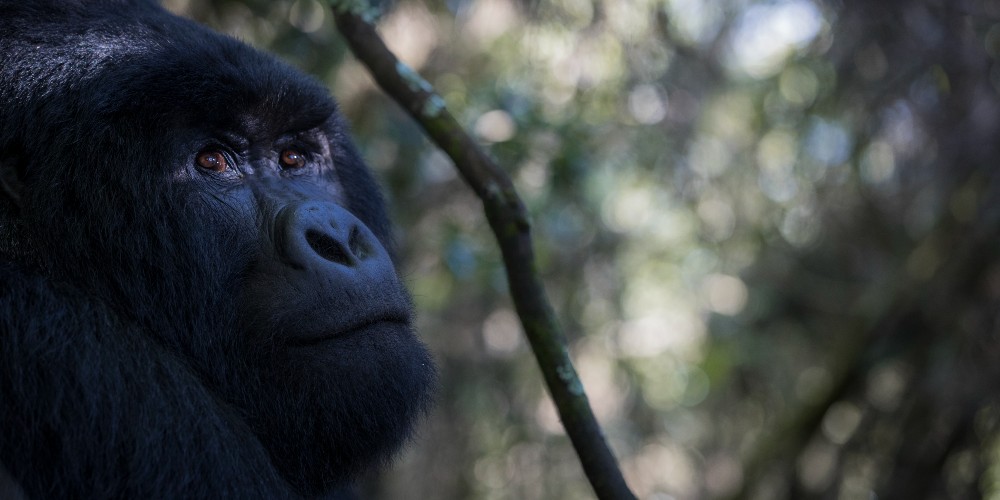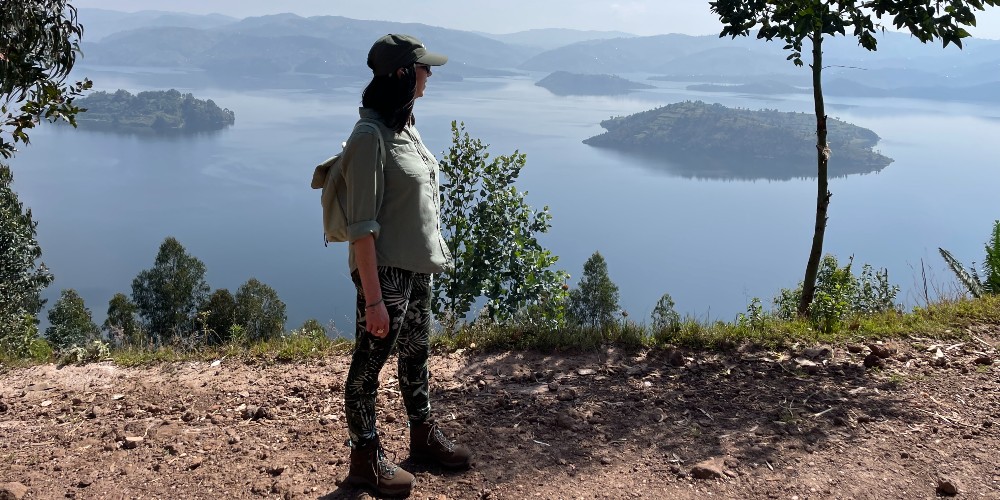On the trail of once-in-a-lifetime, Kate Wickers and her teenage son go mountain gorilla trekking in Rwanda and Uganda and discover a family adventure like no other.

Kate and Freddie find adventure for real
Sunlight filters through a tangle of vines to dapple a glade ringed with bamboo, where Marambo, a 180kg silverback mountain gorilla, is having his thick spongy hair meticulously groomed by a female, one of eight in his hareem.

Mother and child moment
Their baby – all frizzy hair and huge brown eyes and, at three months, the youngest of the group – climbs clumsily over his dad’s considerable rear. Nearby two juvenile males are larking around in mock combat, tumbling over the ground, beating their chests, and flashing each other their gnashers, while a young female sits in solitude in a beam of sunlight, chin raised, eyes closed, enjoying the sun on her face. I squeeze my son’s arm at the luck and privilege of spending time with Marambo and his family.

Intore Dancers, Virunga Lodge
Never too grown up for gorilla trekking in Rwanda
Freddie is my youngest son and has just turned 17. He hasn’t yet begun to talk about holidays with friends, but I know it is coming because this, of course, is the natural order of things. Like his two older brothers, trips away with girlfriends and mates will soon take priority over travelling with us.
But I brush away thoughts of an impending empty nest and tell myself not to be silly because mountain gorilla trekking in Rwanda and Uganda is one of the most adventurous holidays that a family with older teens can enjoy together, and there are still wonderful travel memories to be made.

Dian Fossey grave, Volcanoes National Park
Only 1,063 mountain gorillas are left in the wild
According to a 2019 census, there are around 1063 mountain gorillas left in the wild, with 604 residing within Volcanoes National Park (a string of dormant volcanoes that make up the Virunga Massif) shared by Rwanda, Uganda, and the Democratic Republic of Congo, Another 459 live in Bwindi Impenetrable National Park in Uganda, and we are heading to both.

Virunga Lodge craftspeople
Volcanoes National Park in Northwest Rwanda
We begin our travels in Volcanoes National Park, in northwest Rwanda and the three-hour drive from Kigali gives us a colourful insight into rural Rwandan life. The short distance between small communities means you’re never short on spectacle, with a steady flow of people transporting goods by foot and bike.
We marvel at the weight women carry on their heads – sheaves of maize, bundles of sugarcane and yellow water containers – while the men load goods on to rickety bikes, everything from the sheep that Freddie spots to sofas (this must be seen to be believed).
Flashing by are field upon field of potato and cassava; small-scale family-owned banana and avocado plantations; wooden drying frames for corn cobs (one of the most popular Rwandese snacks); and a market that appears to sell nothing but cabbages. Until finally, the tarmac runs out and we turn on to red dust roads for the bumpy ascent into Virunga and our home for the next few days: Volcanoes Safaris’ Virunga Lodge.

Virunga Lodge, Volcanoes National Park
The dream of luxury ecotourism in Rwanda and Uganda
Celebrating 25 years of responsible wildlife ecotourism in Rwanda and Uganda, the group has four luxury lodges (one in Rwanda, three in Uganda, with a fifth to open later this year). Virunga lodge is a dreamy place, set high on a hill with views to the volcanoes and to lakes Bulera and Ruhonduo, dotted with tiny islands.

Standard Room, Virunga Lodge
The design is Afro-shabby-chic, with plenty of handmade traditional crafts and objet d’art reflecting the local culture and landscape.
Luxury comes in small, thoughtful touches: a fire lit in the hearth of our suite; hot water bottles discovered within our mosquito-ned draped beds; and a lullaby sung in national language Kinyarwanda outside the window each morning as an alarm call.

Bwindi Lodge Tea Project, Uganda
Meeting Marambo head of the Muhoza gorilla family
We meet Marambo, leader of the Muhoza gorilla family, on our first morning after picking our way through purple-flowering fields planted with Irish potatoes and the daisy-like pyrethrum, grown to make a natural insecticide, until we reach the mist draped Volcanoes National Park.
Our escorts are a National Park Ranger and guard carrying a large rifle. I’d promised Freddie an adventure and things are looking good.
“It’s for scare shooting,” ranger Christophe explains when I raise my eyes at the sight of the firearm. “We often meet buffalo in the forest, and occasionally elephant, and if startled they can charge.”
“Anything else that can go wrong?” I ask.
“Not if we stick to a few rules,” he says. “But it’s wise to learn a little gorilla language in case we need to soothe one.”

Kate and Freddie mountain gorilla trekking
Learning the language of gorillas for starters
For a moment I think he’s joking, but soon the five of us in the group (the maximum group size is eight) are soon practising a ‘mm mer’ sound. The ‘mm’ we learn should be short, and the ‘mer’ longer, like the softest of lamb bleats, and both are to be delivered in a low tone.
More advice follows: to make yourself submissive by crouching down if a silverback or black back (young alpha male) approaches, to talk in low voices, to make no sudden movements, and turn the flash of your camera off.
My heart pumps both with excitement and in coping with the altitude of 2,500 feet, as I follow Christophe along a single file track flanked by thick vegetation. Ahead I hear the swish of machete as the guard cuts away bamboo and giant nettles.

Baby Gorilla, Rwanda
Nothing prepares you for the first sight of mountain gorillas
Before reaching Marambo in his sun-drenched clearing, our first sight of gorilla is when a juvenile swings Tarzan-like from a vine before us, and an adult female emerges from the ferns next to Freddie. “Stay calm, let her pass,” Christophe tells him. No wildlife documentary or YouTube video can prepare you for this moment.
Despite the heat, I feel my hair stand on end, and remind myself to breathe. The rule is to stay seven to ten metres away, but no one has informed the gorillas and on steep, narrow mountain trails shoulders often brush. She passes within a hairbreadth, followed by a young male that gives the bottom of my trousers a cheeky pull as he rushes by.
The next hour we spend with them is magical and once back at the lodge we swap gorilla photos and relive our first encounter still shaking our heads at the wonder of it all. Freddie is already declaring that this is the best trip we’ve ever taken.
- Golden Monkey, Volcanoes National Park
- Treehouse hide, Mount Gahinga
Uganda: Where Gold Meets Silver
Perhaps the biggest challenge with teenagers in tow are the early morning starts. “Not 6am again!” Freddie groans, but he soon forgets the lack of a lie-in when a new adventure beckons.

Mount Gahinga Lodge
On day three we cross the border into Uganda and drive for two hours to Mount Gahinga Lodge, within walking distance of Mgahinga National Park, the name given to the Ugandan section of the Volcanoes National Park. The marketing slogan here is ‘Where Gold Meets Silver’, referring to the one habituated (accustomed to people) family of gorillas that resides here, and the troops of endangered golden monkeys with powder puff faces, that dwell amid thick thickets of bamboo.

Deluxe Bedroom, Mount Gahinga Lodge
Views are to verdant crater cauldrons and distant volcanoes
Views are to verdant crater cauldrons on lowers hills and above to three volcanoes – Mount Gahinga, Mount Muhabura, and serrated-peaked Mount Sabyinyo, meaning ‘old man’s teeth’.
We hike through secondary forest, spotting blue-headed sunbirds and red-faced woodland warblers, to the primary bamboo, where the first flashes of bright golden-orange fur belonging to upper flanks and backs of the golden monkeys are spied amid the green.
They leap between trees to seek out the choicest berries, then drop to the forest floor to chomp on the stalks of red-hot pokers and sweet bamboo saplings, and Freddie is soon among them taking selfies to snapchat to friends.

Mountain Gorilla, Bwindi Impenetrable Forest
Enter the wilds of Bwindi Impenetrable Forest
Bwindi Impenetrable Forest lies a bone-shaking, three hour drive from Gahinga Lodge. In the southwest of Uganda, it’s home to a further 459 mountain gorillas. In order to shave off an additional two-hours of being tossed around like peas in a tin by jeep, we opt to take a three-hour trail on foot along an old logging road that cuts a narrow swathe through a forest of giant ferns to Bwindi Lodge.
Red tailed monkeys swing high from African Brown Mahogany trees, cream-banded swallow tail and iridescent blue nymphalid butterflies flit over small burbling steams (just two in 310 species found here), and black and white colobus monkeys watch with obvious curiosity as we hike by, accompanied by three baggage porters and a ranger.

Bwindi Lodge, Uganda
Bwindi Lodge, chameleon for company and the Orozugo gorilla family
It’s a tough call, but Bwindi is perhaps our favourite of the lodges. The extra effort required to get there gives the small town a pleasingly final frontier vibe and the views are to the forest, from which the buzz and click of insects and chirp of abundant bird life never ceases.
Plus, Freddie’s room comes with a free pet: a chameleon, discovered mid transformation from purplish red to mottled brown.
We hire porters to carry our daypacks and packed lunches (tourists are encouraged to do so as it brings much needed income to this isolated community) as it’s a knee-crunching climb down through tea plantations, then an even steeper climb up the Ruhija sector of Bwindi’s thick primeval forest to meet the ten-strong Orozugo family.

Kate Wickers takes a moment
An hour with Bakwate king of the silverbacks
Bakwate is the king here, a 20-year-old silverback, he’s lying flat on his back with his feet up when we arrive. So the trackers cut a path through dense thorny brambles and a tangle of vines to where three females are feeding on stems and leaves, while the youngest member of the group, at just one year, clumsily beats his chest.
“He’s showing off,” ranger Wilbur tells us. “He’s saying, look at me! See how strong I am!”
We’re all so mesmerised by the baby’s antics that we don’t notice that Bakwate has stirred, arriving to us with a heart-stopping gallop, the glossy saddle of silver on his back bristling. We offer a hasty “mm mer,” while dropping to a crouch, but there’s no need for concern as he is already stealthily climbing a moss-cloaked tree to feast upon the highest, choicest leaves.
“Perhaps we could come back to visit the chimpanzees at Kampala next year?” Freddie whispers when our guide informs us that our final hour with the gorillas is up. I grin and give him a hug, happy that my last bird isn’t in a hurry to leave the nest.
How to plan your Rwanda trip
How to get there
One-stop flights to Kigali, Rwanda, are available from New York, Washington D.C. and Boston
Where to stay
Virunga Lodge, Rwanda, Mount Gahinga Lodge, Uganda, and Bwindi Lodge, Uganda
Good to know
Kate and her family travelled with Volcanoes Safaris. Four to 10-day safaris are available.
Scott Dunn Luxury Travel also handcraft family vacations to One&Only Gorilla’s Nest in Rwanda



